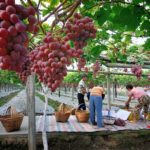Sparkling wine in China: will demand match supply?
Contact us to know more about the Sparkling Wine industry in China at, dx@daxueconsulting.com
 The consumption of wine in China has risen progressively during the twenty-first century and is showing no signs of decline. Indeed, the International Wine and Spirit Research Institute predicts that in 2016 3 680 000 000 cases of wine will be consumed. This is a significant increase in the 3 390 000 000 cases drunk in 2013, with an increase of 8.5% within this period. China is now the fifth largest consumer of wine globally and is producing so much wine that it ranks only behind Spain in the percentage of the worlds vineyard acreage, with 11%. This rise is without doubt due to the appetite Chinese consumers have for red wine. By 2014 China had become the largest consumer of red wine in the world, overtaking France. Moreover, between 2015 and 2020 Euromonitor International believe that the total growth in the volume of red wine in China will increase by 82.4%. The growth of red wine in China, however, has also been complimented by an emergence of sparkling wine. Indeed, between 2010 and 2015 the total growth in the volume of sparkling wine in China was 352.7%. Furthermore, high-quality sparkling wines have established vineyards in the mainland. The LVMH Group pioneered Chandon in China in 2013 with a vineyard at the foot of Helan Mountain. By contrast to red wine, though, the volume of sparkling wine is due to stagnate and decline. Euromonitor International predict that it will drop by 6.9% between 2015 and 2020. Not only is this conflicting with the growth of the wine industry in China generally, but also with the demand for sparkling wine worldwide and in other developing countries. Between 2015 and 2019 the global consumption of sparkling wine is meant to increase in volume by 7.4%. Meanwhile, developing countries, such as Brazil, have been consuming far greater volumes of sparkling wine than China. In 2012 they consumed 3 025 000 9 liter cases, whereas China only drunk 416 000. Daxue Consulting has already explored in previous posts why sparkling wines, such as the iconic Champagne, have struggled upon entry to the Chinese market. There are issues ranging from taste to cost. Nevertheless, the sparkling wine sector in China can learn from changes in the consumption of red wine to revert decline back to growth. This article will explore these lessons and how the sector is currently responding.
The consumption of wine in China has risen progressively during the twenty-first century and is showing no signs of decline. Indeed, the International Wine and Spirit Research Institute predicts that in 2016 3 680 000 000 cases of wine will be consumed. This is a significant increase in the 3 390 000 000 cases drunk in 2013, with an increase of 8.5% within this period. China is now the fifth largest consumer of wine globally and is producing so much wine that it ranks only behind Spain in the percentage of the worlds vineyard acreage, with 11%. This rise is without doubt due to the appetite Chinese consumers have for red wine. By 2014 China had become the largest consumer of red wine in the world, overtaking France. Moreover, between 2015 and 2020 Euromonitor International believe that the total growth in the volume of red wine in China will increase by 82.4%. The growth of red wine in China, however, has also been complimented by an emergence of sparkling wine. Indeed, between 2010 and 2015 the total growth in the volume of sparkling wine in China was 352.7%. Furthermore, high-quality sparkling wines have established vineyards in the mainland. The LVMH Group pioneered Chandon in China in 2013 with a vineyard at the foot of Helan Mountain. By contrast to red wine, though, the volume of sparkling wine is due to stagnate and decline. Euromonitor International predict that it will drop by 6.9% between 2015 and 2020. Not only is this conflicting with the growth of the wine industry in China generally, but also with the demand for sparkling wine worldwide and in other developing countries. Between 2015 and 2019 the global consumption of sparkling wine is meant to increase in volume by 7.4%. Meanwhile, developing countries, such as Brazil, have been consuming far greater volumes of sparkling wine than China. In 2012 they consumed 3 025 000 9 liter cases, whereas China only drunk 416 000. Daxue Consulting has already explored in previous posts why sparkling wines, such as the iconic Champagne, have struggled upon entry to the Chinese market. There are issues ranging from taste to cost. Nevertheless, the sparkling wine sector in China can learn from changes in the consumption of red wine to revert decline back to growth. This article will explore these lessons and how the sector is currently responding.
How do red wine producers do it?
 Chinese consumers drink wine for the two purposes of status and pleasure. Indeed, 50% of wine consumers in China are between the ages of 25 and 44 and associate the drink with luxury and culture. Drinking wine in China is deeply entwined with the image it promotes and it is no surprise, therefore, that Chinese consumers pursue the very best. 10% of total wine consumption in China is that of premium wines, whilst in 2015 it was recorded that of the 4 500 000 expensive bottles of wine bonded at Berry Bros & Rudd’s wine warehouse, 1 000 000 were owned by Chinese customers.
Chinese consumers drink wine for the two purposes of status and pleasure. Indeed, 50% of wine consumers in China are between the ages of 25 and 44 and associate the drink with luxury and culture. Drinking wine in China is deeply entwined with the image it promotes and it is no surprise, therefore, that Chinese consumers pursue the very best. 10% of total wine consumption in China is that of premium wines, whilst in 2015 it was recorded that of the 4 500 000 expensive bottles of wine bonded at Berry Bros & Rudd’s wine warehouse, 1 000 000 were owned by Chinese customers.
The emphasis on status has had affects on the sales of red wine in China. Bordeaux quickly became the most popular region because of the iconic wines the 1855 classification system promoted. Indeed, the greatest volume of red wine grapes consumed in China, according to Euromonitor International, in 2015 were Merlot and Cabernet Sauvignon, the two most prominent grapes varieties from Bordeaux. Due to branding and taste, the red wine industry began to prosper. Consequently, one must conclude that for other wines to succeed in China they must attempt to appeal to Chinese consumers in comparable branding to the premium French red wines. Clarets, for example, have a unique history and recognized quality. This has been advertised effectively to Chinese consumers.
Additionally, by assessing the efforts of wine makers, such a Cecil Park, one can comprehend alternative pathways to success. Park does not produce wines of a similar history to premium clarets. Indeed, her Californian blend is predominantly pinot noir, whilst being strongly supported by Syrah and petit Syrah with just a small hint of Merlot. Nevertheless, she is very aware that she must comprehend the exact tastes of her clients, depicting herself as ‘more of a listener than a talker’. Her aim is to find a ‘common language’ with her clients in Asia so that she can tailor her produce to suit their taste requirements. It is clear that those driving the red wine sector forward in China either push their branding or match the taste of their produce specifically to please their target audience. Sparkling wine producers around the world must take note if their wines are to flourish in China too.
Will producers of sparkling wine in China prosper similarly?
Although Guillaume Deglise, the CEO of Vinexpo, acknowledged that the dominance of red wines in the Chinese market would continue for the ‘near future’, it is clear that leaders in the sparkling wine industry from around the world are aware of what they must do. Indeed, Prosecco is an Italian sparkling wine that holds a specific geographical location and an established position amongst Italian wines more generally. With 70% of its produce sold abroad in 2014, it is appreciated globally. Such is the demand elsewhere that the UK’s prosecco market has grown 35% in the last two years. Giancarlo Polegato, the CEO of the prominent Prosecco producing Villa Sandi, however, has acknowledged that Chinese consumers still view the beverage as a ‘poorer version’ of champagne. A lack of information and branding is preventing Polegato from entering a ‘prime market’ and succeeding like French red wine producers. Moreover, Prosecco is a drink that could potentially appeal to Chinese consumers as it has a specific status, like many French wines, and has global popularity. Consequently, Polegato is intent to ‘engage with consumers’ to teach them of the history behind his produce and its distinctive flavor. This desire and understanding of the Chinese market orientation will be vital if his efforts are to be profitable. He wants to engage with consumers to promote Prosecco’s unique history, location, and taste. Perhaps with time and a maintenance of this attitude, premium sparkling wines, such as Polegato’s Prosecco, will be increasingly appreciated by the Chinese market.
The Chinese in the twenty-first century have consumed vast quantities of wine. This has, however, been predominantly red wines. Furthermore, the volume of red wine consumed in China is only meant to increase. Although sparkling wines have entered the Chinese market, it has never reached the level of French red wines and is also set to decline. From analyzing how producers of red wine have been so successful, one can see that they have understood very closely the Chinese market orientation. With status-focused branding and research-based blends, they have satisfied the tastes and ideals of Chinese consumers. Sparkling wine producers must adapt to the Chinese market orientation comparably. If they act appropriately on ambitions, such as those of Polegato, they stand a far stronger chance of generating profit and growth in the future.
Case Study: A client in the Wine industry
Daxue Consulting has conducted a price monitoring methodology for one of its client, wine producers and exporters. In order to provide the most up-to-date market intelligence, Daxue Consulting had monitored in-store strategies implemented on the Chinese market in tier 1 and tier 2 cities, with a focus on the pricing policies, regarding the origin, the size of the bottle, the year etc. A monitoring report was sent to the client every 3 months, including photos, prices, description and evolution of the products.
See also:
- How to sell wine to Chinese consumers ?
- See our Latest infographics on Twitter:
#Chinese consumers place value on high quality #beverage products. Get all the facts at https://t.co/JwlOTKuuzr pic.twitter.com/MMs80W5LXk
— Daxue Consulting (@DaxueConsulting) September 11, 2015














